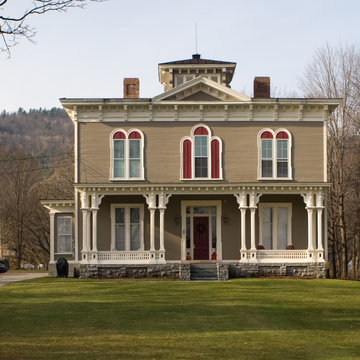This landmark Italianate house epitomizes the prosperity brought to West Rutland by the marble industry. A source for tombstones, local marble was not exploited systematically until 1838 by William Barnes and Lorenzo Sheldon. They were joined by David Morgan and Charles Slason to open the first quarry in 1844. As Sheldon and Slason, then Green Mountain Marble, and ultimately the West Rutland Marble Company, their business boomed, especially with the opening in 1850 of the Rutland and Whitehall Railroad. In the next decade, a government contract to supply two hundred and fifty-four thousand head-stones for Civil War dead brought further expansion. Along with extensive mills, railroad spur, company store, and some one hundred and forty tenements, company officers also built fine houses, many of them along Clarendon Avenue just south of Main Street.
The most elaborate and pretentious house was that of company president David Morgan. It is a cubic frame house, with bay windows and verandas, a low hipped roof with a central pediment on each face, and is crowned with a belvedere. Tall second-story windows are round-headed and massive scroll-sawn brackets support the porch roof and the eaves. The house showcased the company's wares as well as its profits in its rusticated marble foundation and marble parlor mantelpieces within.


